He sat on a school bus, looking out at Arroyo Grande High School. But he was sitting by his parents and little brother while the friends and schoolmates he usually sat next to were all standing outside, watching him leave.
“I was kind of sad,” Haruo Hayashi said of that day in the spring of 1942, when he was just another 16-year-old kid. “It wasn’t a happy thing, but you knew who your friends were.”
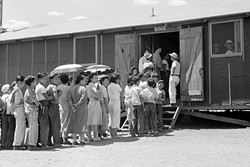
- PHOTO COURTESY OF THE NATIONAL ARCHIVES AND RECORDS ADMINISTRATION
- RATIONS: People wait in line for lunch outside the mess hall at the internment camp at Manzanar in 1942.
Just months earlier, President Franklin D. Roosevelt signed Executive Order 9066 in the midst of World War II. It effectively imprisoned 120,000 people of Japanese descent—even American citizens—who lived in the Western part of the United States (including about 1,000 people from SLO County) in internment camps. After the war, Japanese farming families like the Hayashis returned to the Central Coast to rebuild their lives from the ground up.
February marked the 75th anniversary of the now infamous signing of that 1942 executive order. Eva Ulz, executive director at the History Center of San Luis Obispo County, sought to bring to light the achievements of the local Japanese community alongside a darker chapter of the nation’s history. On the Day of Remembrance, Feb. 19, the center celebrated the opening of its Tranquility Disrupted: Japanese Internment and San Luis Obispo County exhibit. Members of the Japanese community, including the now 91-year-old Haruo, attended the event. The exhibit highlights different members of the Dohi, Fukuhara, Hayashi, Loomis, Ikeda, Nagano, and Eto families’ stories of that time and the ways their lives changed forever.
“It became really apparent to us that’s where our responsibility lay, to give voice to these stories,” Ulz said. “They’re really stories that we need to hear—and especially, we need to hear them right now.”
Going down to Gila River
In 1942, the Hayashi family had about 100 acres of land (mostly leased) that they farmed with lettuce, celery, and beans. Haruo’s father, Yeiju Hayashi, immigrated to the U.S. from Japan in 1918, going through South America to Mexico before finally being brought over the border by a paid coyote smuggler. Once in California, Yeiju married his wife Toyo and they settled down in Arroyo Grande, where Haruo was born in 1926, followed shortly by his little brother Akio.
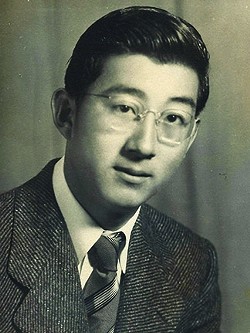
- PHOTO COURTESY OF THE HISTORY CENTER OF SLO COUNTY
- BACK IN THE DAY: In 1942, Arroyo Grande farmer Haruo Hayashi was just 16 years old when he and his family were moved to an interment camp in Gila River, Ariz., after President Franklin D. Roosevelt signed Executive Order 9066.
When Japan bombed Pearl Harbor on Dec. 7, 1941, the U.S. promptly entered World War II and the fate of the Hayashi family was sealed just two months later. But Roosevelt’s order only applied to Japanese people living in the West, and camps weren’t established right away. Initially, the order simply required people of Japanese descent to leave so-called military areas. The government quickly realized that most people didn’t have anywhere to go to. By that summer, families like the Hayashis were put on buses and forced to leave. Haruo thinks they left Arroyo Grande in May or June that year, first going to a temporary assembly center in Tulare. The center was erected on what was once a horse track; Haruo and his family slept in old stables.
“It didn’t smell that good, but you get used to it, you have to,” he said.
That’s about as harsh a thing as you’ll ever hear Haruo say about his experience. Haruo’s son, Alan, who mans a booth stacked with strawberries Thursday nights in downtown SLO, grew up angry about what his parents went through and even got into fights with other kids who mouthed off about it. But Alan said he never really saw any anger or bitterness about it from his mom or dad.
“Were you there?” Alan’s mother, Rose, asked him after he got into a fight around age 11. “I was, and I’m not mad. If you grow up angry, you’re just never going to get anywhere. If your father and I were angry then he wouldn’t have been as successful as he was. Being mad doesn’t get you anywhere.”
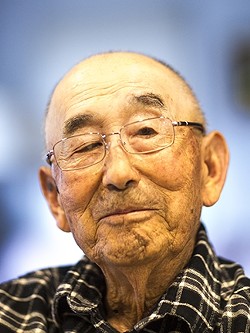
- PHOTO BY JAYSON MELLOM
- ROOTS: Haruo Hayashi, a Japanese American farmer and internment camp survivor, still lives in the Arroyo Grande house he was born in 91 years ago.
After hearing that, Alan said, he stopped getting into fights over words.
Haruo and his family were eventually moved from Tulare to the internment camp at Gila River in Arizona. While these places were euphemistically called “assembly centers,” “relocation centers,” and “internment camps,” Ulz said they were effectively concentration camps. Wooden shack-like structures were built, 20-by-100 feet, with partitions on the inside so that four families could share each building. It was crowded and noisy, hot in the summer, and windy and cold in the winter. But life went on. The government tried to create a sense of normalcy at the camp, with school lessons for kids and jobs for the adults. Haruo worked for a time as a dishwasher for $6 a month, while his dad worked as a foreman at the farm where they raised food for the camp. Haruo wrote letters to his friends back home and even formed a big band group with some of the other teens at the camp.
Still, it wasn’t exactly life as usual. Living situations were substandard, food was distributed, and basic necessities like soap were carefully rationed.
“It was crowded, but I guess, it’s the best they did,” Haruo said.
Learning from history
While it’s easy to see the link between Japan bombing Pearl Harbor and distrust that grew into prejudice and outright discrimination against anyone of Japanese descent in the U.S., Ulz said it goes back further than that. In the Tranquility Disrupted exhibit at the center, a letter from the governor of California implores the governor of Washington to help in the fight to “secure absolute exclusion of Japanese immigration.” The letter is dated April 20, 1921. A letter published in SLO County’s own daily paper, then the Telegram-Tribune, in January of 1942 said that while maybe not all “Japs should be put in internment camps, I do advocate that each residence and place of business … be searched thoroughly … .”
“It’s obvious that like so many times in war, you take advantage of an exigent situation to do something that you’ve been meaning to do,” Ulz said.
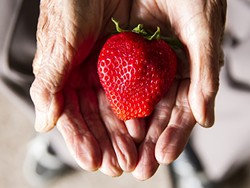
- PHOTO BY JAYSON MELLOM
- LOCAL: Haruo Hayashi, 91, whose family is known for farming strawberries in SLO County, said he’s had enough of berries.
And while those interned like Haruo could theoretically leave if they had somewhere outside of the western portion of the country to go, that was rare. But some made their way out of the camps before the war’s end through family connections, admission to universities in the Midwest, and military service.
“It was incarceration in all practical purposes,” Ulz said.
She’s quick to point out that the executive order never actually used the word “Japanese,” but that’s almost exclusively who the order was applied to.
“They were trying to pave the way constitutionally and legally to do something that was neither legal nor constitutional,” Ulz said.
This particular instance of constitutional overreach, she said, wasn’t seen again in the country’s history, until very recently—in December, when the first iteration of an executive order blocking citizens from a group of predominantly Muslim countries from traveling to the U.S. was signed by President Donald Trump. A second version of the ban was recently temporarily blocked by a federal judge in Hawaii on the basis that it discriminates against Muslims.
Similar to Roosevelt’s 1942 executive order, the ban was lauded by supporters as strengthening national security, with detractors saying it doesn’t accomplish that goal and defies the Constitution. In November 2016, Carl Higbie, a former spokesman for a major super PAC that backed Trump, said the interment camps set a precedent to support a hypothetical Muslim registry. And in a December 2015 interview with Time magazine, Trump wouldn’t say definitively whether he would have supported the internment of Japanese people during World War II.
“I certainly hate the concept of it,” Trump said to Time. “But I would have had to be there at the time to give you a proper answer.”
To Ulz, it looks a little like the beginning of a story we’ve already seen.
“History repeats itself,” she said. “If we allow ourselves to gloss over what happened … we risk repeating the same fear and bigotry that happened at that time. There was an illegal action taken against citizens that were loyal Americans. The issue is that we have chosen to think of this as a gray area.”
Back on the farm
Despite being imprisoned by his country of birth, Haruo opted to serve when the draft opened up to Japanese American citizens later in the war. Haruo wasn’t necessarily trying to prove his loyalty, but he was a young man who felt like he was missing out.
“I was happy because all my friends over here went in the Army and Navy, and we wrote to each other,” Haruo said. “I was kind of t’d off for a while, because I couldn’t join them.”
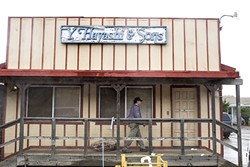
- PHOTO BY JAYSON MELLOM
- BACK AT THE OFFICE: Alan Hayashi, a third generation Arroyo Grande farmer of Japanese descent, walks by the family office, located next to his dad’s house.
Though training was rigorous, much of Haruo’s time in the Army was uneventful due to his bad right eye. During target practice his fellow soldiers would yell “Hayashi’s on the line!” So instead of being sent abroad, Haruo was stationed at the military base in Monterey. He was released from service in 1945, just before the war ended. After that, Haruo picked cabbage in Utah for six months to save enough money to get his parents out of the camp. Then, the Hayashi family returned to the farm in Arroyo Grande.
“When we came back, everything was ready,” Haruo said.
While they were gone, good friends and neighbors like John Enos, Gus Phelan, and Joe Silva took care of the land, leasing it out during the war so the Hayashis wouldn’t be starting from scratch. Vard Loomis did the same for the Ikeda family in Arroyo Grande and the grateful farmers, Kazuo and Mitzi Ikeda, named one of their children (Randall Vard Ikeda) after him. While Japanese American farmers having land to come back to after internment wasn’t unique to the Central Coast, Ulz said it wasn’t necessarily happening everywhere.
“The families that owned land were often able to come back to that land, but the vast majority weren’t able to own land and couldn’t return,” she said.
While Haruo heard of other Japanese families who returned home to SLO County and faced harassment, his own family was relatively unscathed. He attributes this, in part, to friends and neighbors who looked out for them. Haruo said when the war first started, a friend told him that if anyone called him a “Jap” to let him know and he’d “beat the shit” out of them.
But prejudice still existed. The movie theater in Pismo Beach wouldn’t admit Japanese American people until more and more veterans of Japanese descent started returning home from the war.
Eventually Haruo met and married his wife, Rose, they had five sons, and later seven grandchildren. While two of his boys are local doctors, Haruo said most of his kids are involved in the family farming business in one way or another. The Hayashis now have 300 acres of farmland on the Central Coast and Haruo still lives in the Arroyo Grande house he was born in 91 years ago. The now famous Hayashi strawberries can be found at local farmers markets and the Hayashi farm stand.
“Everything worked out good,” Haruo said. “I’m happy that I’m still here.”
Honoring the past
Today, the mark of Japanese American families can still be seen across the county. Ulz said that while the Japanese are now integrated into the greater community, their contributions to the region still stand out.
“They really singlehandedly created this vast agricultural engine on the Central Coast,” Ulz said.

- PHOTO COURTESY OF THE NATIONAL ARCHIVES AND RECORDS ADMINISTRATION
- MANZANAR: Memorial Day services in 1942 at Manzanar, Calif., an interment camp where people of Japanese descent were sent during World War II.
In the early 20th century, Japanese families were farming much of the land from the hills of Avila Beach to Arroyo Grande. These farmers helped to start the Pismo Oceano Vegetable Exchange in 1922 and popularized pole peas, which became sought after for their quality and sweet taste. Tom Ikeda, current president of the exchange, said the pole peas allowed farmers to ride out the Great Depression relatively unscathed.
He said there’s a rumor that a Japanese farmer in the Santa Maria Valley was the first to plant broccoli west of the Mississippi. It’s now one of the biggest crops in SLO and Santa Barbara counties.
“It’s been a positive impact,” Tom said. “Not to say that others haven’t brought new crops to the area, but the Japanese farmers were very innovative in how things were done.”
Growing up in Arroyo Grande, Tom’s sister, Margaret Ikeda, felt like she was related to every single Japanese American person in the area. And she kind of is. That’s because the Ikedas are not-so-secret Hayashis. (Margaret and Tom’s uncle, Mitsugi Fukuhara is also featured in the exhibit at the history center.) When their grandparents Juzo Hayashi and Sei Ikeda married, Sei was coming from a family of all daughters. Concerned about the Ikeda name dying out, her family asked Juzo to carry out the Ikeda name on their behalf, a practice that’s fairly common in Japan.
The pair only spoke Japanese, so while they were alive, Margaret’s parents served as translators between them and the grandkids. Margaret said she once asked her father, who was interned with his parents, why they didn’t speak Japanese to them when they were young.
“He looked at me like I had no understanding of the political context they were living in,” Margaret said. “Their job was to be Americans and teach us to be Americans and speak English, not an enemy language. The ability to access the culture through language was lost to us.”
- REVISITING THE PAST: The Tranquility Disrupted: Japanese Internment and San Luis Obispo County exhibit will show through July 31 at the History Center of SLO County. Visit historycenterslo.org for more information.
But Arroyo Grande had a Japanese language school that was started in the 1920s and a hall for community activities on East Cherry Avenue. It’s unclear when each closed down, but Margaret remembers her older cousins taking Japanese lessons at the hall for a time in the 1960s.
Margaret, now in her 50s, also remembers people talking about what to do with that property when she was a teenager. The South County Historical Society hosted a yearlong exhibit in 2008 on the local Japanese community, which once again piqued interest in doing something with the space. In 2011, when the structure burned down, conversations and interest around rebuilding grew. With the support of the local Japanese community and the Arroyo Grande Valley Japanese Welfare Association, Margaret, now a Berkeley-based designer, and her husband, Evan Jones, an architect, started drawing up plans in 2013 that reimagined the space as a garden of sorts.
In January, the Arroyo Grande City Council approved the Garden of Enduring Values project, which includes historical residential and public assembly areas, a commercial farm stand, a garden, and an orchard with Japanese cherry trees. The project is still in the fundraising stage, but Margaret is hopeful for the garden’s future and mindful of its connection to the past.
“It was the wish of my parents’ generation that their parents be honored,” Margaret said.
Ryah Cooley is New Times’ arts editor. Contact her at [email protected].
Comments